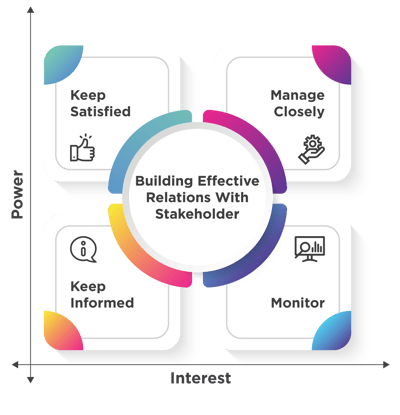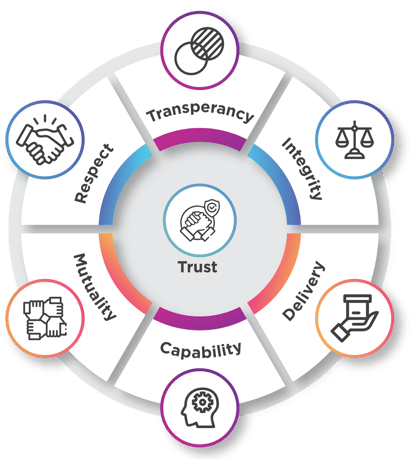We have seen a lot of emphasis on Stakeholder Relationships within project management over the past few years. But how does a project manager make this happen?
Let’s take a look:
Every individual who creates an impact or an influence within an organization is called a Stakeholder. Developing and maintaining strong relationships with stakeholders takes time, effort, and a well-thought action plan. The key advantage of maintaining positive stakeholder relationships is that it allows you to develop a collaborative approach, which aids in the development of trust and goodwill toward you and your organization. It means an effective stakeholder relationship management strategy is essential for the success of any individual or an organization.
If you succeed in building the right relationship with your stakeholders, then he/she will become a key player or project champion, assisting the firm in becoming a Brand. In consequence, if you fail to do so then he or she will become a disaster for all. The organization might have to engage and invest more in senior resources to fix very minute-level issues. As a result, stakeholder engagement is essential.
There are a few key points that will play a major role in improving stakeholders’ engagement
The very first step is to identify Stakeholders. A very basic key is, that every person who is directly or indirectly engaged in the project is your stakeholder. Direct stakeholders are those who interact at a regular interval (daily, weekly, and so on) through meetings, email, or in person. On the other hand, indirect stakeholders are those indirectly linked with the project such as a project sponsor, the head of the department, consumers, and so on.
After identifying, the second very important step is to analyze them and prepare yourself whenever you interact with them. One of the best ways I prefer is to create two matrices that are helpful to deal with them:
1. Power-Interest Matrix
Divide them into four quadrants

- High Power & High Interest - Are major stakeholders who heavily invest in the project & actively manage it
- High Power & Low Interest - These stakeholders must be kept satisfied even though they are not interested as they yield power. Or else they might derail the project even for minor issues
- Low Power & High Interest - Must be kept informed as they are a high influencer
- Low Power & Low Interest - Must be monitored as they may move to any of the above in future
2. Stakeholder Analysis Matrix
Every stakeholder falls into one of the following five categories based on the level of support for the project:- Leading - Are actively working to ensure its success
- Supportive - Aware of the project’s potential impact and are supportive of the change
- Neutral - No opinion regarding their support for the project
- Resistant - Are resistant to the change
- Unaware - Unaware of the project and any potential impacts on the outcome
| Stakeholders | Unaware | Resistant | Neutral | Supportive | Leading |
| Sponsorer | C and D | ||||
| Product Owner | C | D | |||
| Head | C and D | ||||
| Developer | C | D | |||
| Auditor | C | D |
C – Current Engagement D – Desire Engagement
Identify the current state of engagement of each stakeholder and prepare a plan to move/maintain it to D state as expected engagement.
The heart of the overall blog is to gain stakeholders’ trust right from the beginning for which communication is the key. Stakeholders should have a clear understanding of why they should support or amend a decision rather than resist it. It means even if stakeholders’ don’t reach an agreement on a conclusion, they have the benefits of the outcome. Therefore, there will be fewer objections at the time of delivery.
 Trust Matrix displays a few of the parameters to build trust
Trust Matrix displays a few of the parameters to build trust
To achieve this, make sure your communication is constant throughout the project life cycle. We often find that conversation among employees or with clients is only limited to formal discussion on agenda and that too during a meeting. I believe we should have informal/casual discussions, fun sessions, or entertainment sessions where everyone can take off their formal or diplomatic masks and talk candidly, which will aid in the development of solid relationships that may extend beyond the organization.
Despite all of the aforementioned efforts, certain stakeholders remain reluctant to change. Most of the time, this is due to miscommunication or a confusion gap between the parties. People might be hesitant to openly discuss issues due to ego or linguistic issues, which result in a strong reaction rather than a response. If not stopped at an early stage, it becomes a big concern later. To resolve this and transform it into positive relations for the benefit of the organization’s objective, you’ll need to use a variety of strategies (clear communication, trust-building, and so on).
Finally, I’d like to offer a few tips that will assist you in developing a positive relationship with each stakeholder and correctly grouping them -- When discussing with stakeholders our focus should be on creating values for them by increasing revenue and decreasing expenses
- For some stakeholders, moral and ethical values are very important because they relate to societal norms for behavior. These include obeying the company’s rules, effective communication, taking responsibility, accountability, professionalism, trust, and mutual respect for coworkers. In this case, proper behavior is crucial
- Religious belief also plays a significant influence in establishing a bond. We should respect their viewpoint as long as it does not negatively damage the company’s work culture and, miraculously, becomes a positive influencer
Another key factor that needs to be considered is a political opinion, which determines how they respond to a project that pursues self-interest in an organization in order to preserve individual or organizational interests - Demographics is also equally important when selecting topics and priorities to discuss, as younger and older persons may have different preferences
- I’ll say it again, Communication is crucial. Try to communicate your message through a different media that stakeholders can comprehend easily. If your spoken communication is weak, use email to explain it, and vice versa.





